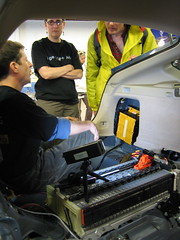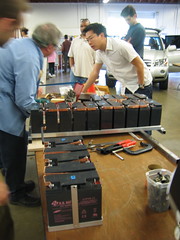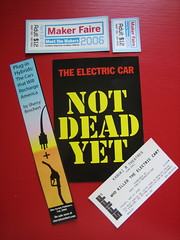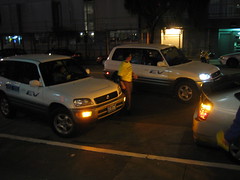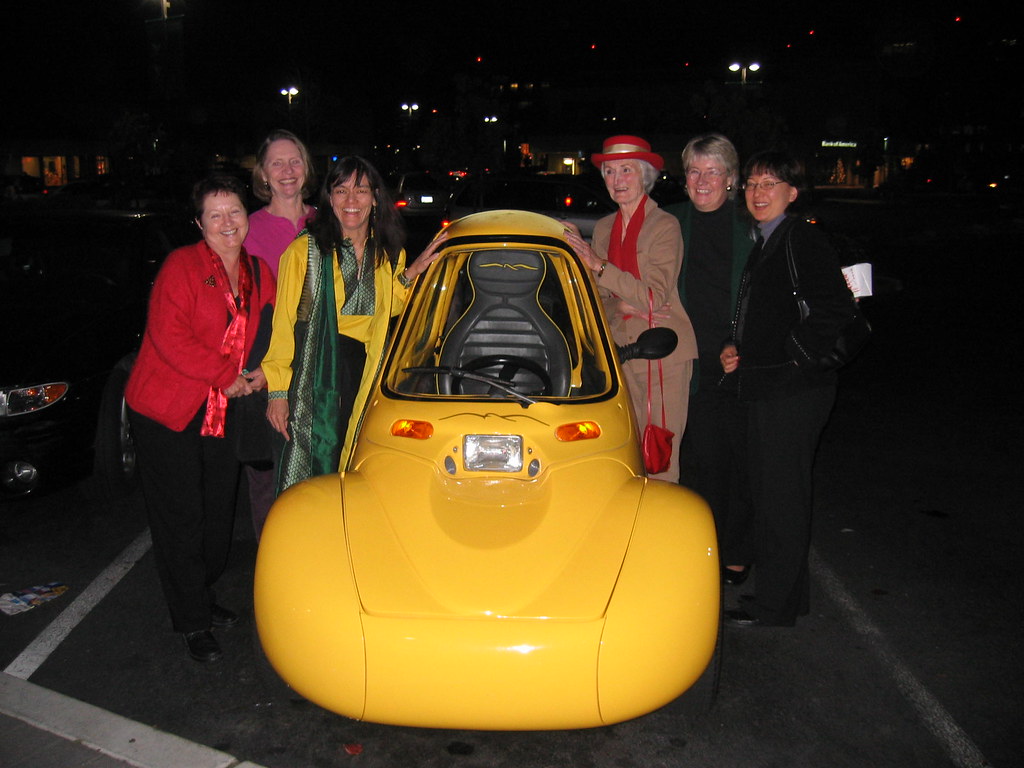Make Faire Plug-in Prius Demo
The CalCars demo at the Make Faire in San Mateo, over Earth day weekend, allowed the public to watch, a team of twelve EV enthusiasts, install an extra battery pack and plug into a 2005 Prius. Only a few asked if we would void the warranty. For the computer and electronics maybe, but not for the rest of it, we told them. What the owner would sacrifice was access to the spare tire as the new batteries would sit on top of the spare tire wheel well, but the cargo space would still be the same.
What people did ask was "why wasn't Toyota doing this?" Our makeshift set-up was so obviously inferior to the resources and brains of a modern automotive factory. And with no access code, we were having to "spoof" the computer, fool it into accepting the new battery pack without shutting off the electric mode and turning on the gas engine. When I told people that Toyota didn't think the public would understand the concept or accept a plug-in option, they rolled their eyes. This was a crowd eager to jump on every new innovation.
The auto industry has many excuses, but we believe that what they fear most is that the electric motor technology would suddenly switch the entire industry over to this superior technology just as digital cameras had rendered film cameras obsolete. The combustion engine, with all its after market servicing needs, would be gone and oil profits with it. Toyota claims that battery technology is not here yet even for a plug-in hybrid, but we know that they made the RAV4 EV with a range of 100 miles using the nickel metal hydride battery (NiMh).
The battery pack being installed into our project were small lead acid batteries used in motorcycles and electric bicycles. They were cheap and available, but would only have a range of 20 miles and would add 300lbs in weight. (I spent a good part of the weekend hammering lengths of copper tubing flat and shaping them into connectors to bolt to the battery terminals, thus forming an electrical path between them.)
The lighter and better performing NiMh batteries are only sold in large lots suitable for mass production. Since an oil interest (Chevron) has a controlling stake in the company that makes them, we suspect that this is an effort to keep home mechanics from building viable electric vehicles. The new hope was in lithium ion batteries. Though expensive, these batteries, in an electric car, would boost performance beyond the combustion engine altogether. The car companies have no excuse.
What we were trying to do was show the public that the technology was here and create a demand for it. Many visitors to the booth thought we were in the business of installing the option ourselves and were annoyed when I told them this was just a demonstration and the only U.S. company able to give them the plug-in option would take 6 months to install it. For about $3,000 in parts they could do it themselves, but what we wanted them to do was go to their dealer and ask for the plug-in option, thus letting Toyota know that we had let the cat out of the bag and consumers were demanding it. Such are the visions of the grass roots activist. The team did not complete the conversion in the two days of the fair. The car was driven to another location where the core group worked on the project all day and evening Monday before it was done and the owner was able to drive his car back to Seattle.
More about the Make Faire demo here
What people did ask was "why wasn't Toyota doing this?" Our makeshift set-up was so obviously inferior to the resources and brains of a modern automotive factory. And with no access code, we were having to "spoof" the computer, fool it into accepting the new battery pack without shutting off the electric mode and turning on the gas engine. When I told people that Toyota didn't think the public would understand the concept or accept a plug-in option, they rolled their eyes. This was a crowd eager to jump on every new innovation.
The auto industry has many excuses, but we believe that what they fear most is that the electric motor technology would suddenly switch the entire industry over to this superior technology just as digital cameras had rendered film cameras obsolete. The combustion engine, with all its after market servicing needs, would be gone and oil profits with it. Toyota claims that battery technology is not here yet even for a plug-in hybrid, but we know that they made the RAV4 EV with a range of 100 miles using the nickel metal hydride battery (NiMh).
The battery pack being installed into our project were small lead acid batteries used in motorcycles and electric bicycles. They were cheap and available, but would only have a range of 20 miles and would add 300lbs in weight. (I spent a good part of the weekend hammering lengths of copper tubing flat and shaping them into connectors to bolt to the battery terminals, thus forming an electrical path between them.)
The lighter and better performing NiMh batteries are only sold in large lots suitable for mass production. Since an oil interest (Chevron) has a controlling stake in the company that makes them, we suspect that this is an effort to keep home mechanics from building viable electric vehicles. The new hope was in lithium ion batteries. Though expensive, these batteries, in an electric car, would boost performance beyond the combustion engine altogether. The car companies have no excuse.
What we were trying to do was show the public that the technology was here and create a demand for it. Many visitors to the booth thought we were in the business of installing the option ourselves and were annoyed when I told them this was just a demonstration and the only U.S. company able to give them the plug-in option would take 6 months to install it. For about $3,000 in parts they could do it themselves, but what we wanted them to do was go to their dealer and ask for the plug-in option, thus letting Toyota know that we had let the cat out of the bag and consumers were demanding it. Such are the visions of the grass roots activist. The team did not complete the conversion in the two days of the fair. The car was driven to another location where the core group worked on the project all day and evening Monday before it was done and the owner was able to drive his car back to Seattle.
More about the Make Faire demo here
